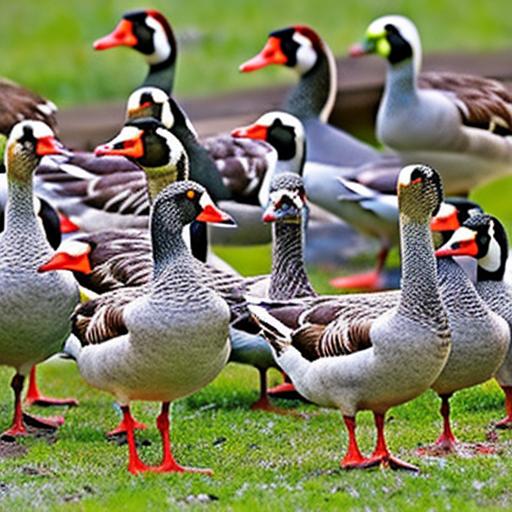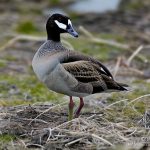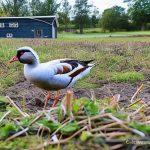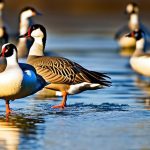Geese are known for their strong migratory instincts and their tendency to form large flocks. They are social birds that often travel in groups, and they are highly adaptable to various environments. Geese are also known for their territorial behavior, especially during the breeding season. They can become aggressive and protective of their nesting sites, which can lead to conflicts with humans.
Geese are attracted to areas with abundant food sources, open spaces, and bodies of water. They are herbivores and feed on grass, grains, and aquatic plants. Geese are also drawn to areas with minimal disturbance, making residential lawns, golf courses, and parks ideal habitats for them. Understanding the behavior of geese is crucial in developing effective strategies for managing and deterring them from unwanted areas.
Geese are also known for their strong homing instincts, which means they will return to the same nesting and feeding sites year after year. This behavior can make it challenging to keep geese away from specific areas, as they will persistently try to return to familiar locations. By understanding the behavior of geese, property owners can develop comprehensive plans to deter them effectively and prevent conflicts.
Key Takeaways
- Geese are territorial and may become aggressive during nesting season
- Fences, hedges, and other physical barriers can prevent geese from entering an area
- Loud noises, predator decoys, and motion-activated devices can deter geese
- Plants like holly, juniper, and ornamental grass can repel geese with their texture and taste
- Removing food sources like grass clippings and garbage can discourage geese from staying in an area
- Consult with wildlife management professionals to ensure legal and humane geese control methods
- Avoid harming geese and their eggs, and comply with local regulations for geese management
Creating Physical Barriers to Keep Geese Out
One of the most effective ways to keep geese out of specific areas is by creating physical barriers that prevent them from accessing those spaces. Fences, hedges, and other structures can be used to block geese from entering lawns, gardens, and other outdoor areas. These barriers should be at least three feet high to prevent geese from easily hopping over them.
Another physical barrier that can be effective in deterring geese is the use of netting or wire grids placed over bodies of water. Geese are drawn to water sources for feeding and nesting, so covering ponds or lakes with netting can prevent them from accessing these areas. Additionally, installing barriers such as low fences or hedges around water features can discourage geese from congregating in these locations.
Property owners can also consider using visual barriers such as shrubs or tall grasses to obstruct the line of sight between geese and their desired locations. By creating physical barriers that limit geese’s access to specific areas, property owners can effectively manage and deter them from causing damage and disturbances.
Using Sound and Motion to Deter Geese
Another effective method for deterring geese is by using sound and motion to disrupt their sense of security and comfort. Geese are sensitive to loud noises and sudden movements, which can make them feel threatened and prompt them to leave an area. Property owners can use devices such as propane cannons, electronic sound emitters, or motion-activated sprinklers to create disturbances that deter geese from congregating in specific locations.
Another method for using sound and motion to deter geese is by employing trained dogs to patrol the area. Border collies and other herding breeds are known for their ability to chase and intimidate geese, making them effective deterrents for keeping geese away from properties. The presence of a dog alone can be enough to discourage geese from settling in an area, as they perceive it as a potential threat to their safety.
Property owners can also use visual deterrents such as reflective tape, scarecrows, or predator decoys to create the illusion of danger and keep geese at bay. These visual deterrents can disrupt the sense of security that geese seek in specific areas, prompting them to seek alternative locations for feeding and nesting. By using sound and motion as deterrents, property owners can effectively manage geese populations and prevent conflicts with these birds.
Implementing Natural Repellents to Keep Geese Away
In addition to physical barriers and sound/motion deterrents, property owners can also implement natural repellents to keep geese away from specific areas. Natural repellents such as grape seed extract, garlic oil, or capsaicin-based sprays can be applied to grass and plants to make them less appealing to geese. These natural repellents create an unpleasant taste or odor that deters geese from feeding on vegetation in the treated areas.
Another natural repellent that can be effective in deterring geese is the use of predator urine or feces. Sprinkling coyote or fox urine around the perimeter of a property can create the illusion of a predator presence, which can deter geese from settling in the area. Similarly, scattering predator feces such as that of coyotes or wolves can create a sense of danger that prompts geese to seek alternative locations for feeding and nesting.
Property owners can also consider planting natural deterrents such as tall grasses, shrubs with thorns, or prickly bushes that create physical barriers and make it difficult for geese to access specific areas. By implementing natural repellents, property owners can effectively manage geese populations without causing harm to the birds or the environment.
Removing Attractants from the Yard
One of the most important steps in deterring geese from specific areas is by removing attractants that draw them to those locations. Geese are attracted to open spaces with abundant food sources and bodies of water, so property owners should take steps to eliminate these attractants from their yards. This can include reducing the amount of open grassy areas, removing bird feeders, and minimizing water features that may attract geese.
Property owners should also consider implementing landscaping changes such as installing gravel or rocks around water features instead of grass, which can make these areas less appealing to geese for feeding and nesting. Additionally, reducing the use of fertilizers on lawns and gardens can help minimize the attractiveness of these areas to geese, as they prefer lush, well-maintained grass for feeding.
Another important step in removing attractants from the yard is by promptly cleaning up any spilled birdseed or pet food that may attract geese. By eliminating food sources and minimizing open spaces and water features, property owners can effectively deter geese from settling in their yards and causing damage.
Seeking Professional Help for Geese Control

In some cases, managing and deterring geese from specific areas may require professional assistance. Property owners can seek help from wildlife management companies or pest control services that specialize in humane methods for managing geese populations. These professionals can assess the property, develop comprehensive management plans, and implement effective strategies for deterring geese without causing harm to the birds or the environment.
Professional wildlife management companies may also offer services such as habitat modification, egg addling (a process of preventing eggs from hatching), or relocation of geese populations to more suitable habitats. These methods can help property owners effectively manage geese populations while ensuring legal and humane practices are followed.
Property owners should also consider consulting with local authorities or wildlife agencies to ensure that they are following legal guidelines for managing geese populations. Some regions may have specific regulations regarding the management of migratory bird species such as geese, so it is important to seek professional help and guidance to ensure compliance with local laws.
Ensuring Legal and Humane Methods for Geese Management
When implementing strategies for managing and deterring geese from specific areas, it is crucial for property owners to ensure that they are following legal and humane methods. Geese are protected under various wildlife conservation laws, so it is important to adhere to regulations regarding their management and control.
Property owners should prioritize using non-lethal methods for deterring geese, such as physical barriers, sound/motion deterrents, natural repellents, and habitat modification. These methods are effective in managing geese populations without causing harm to the birds or the environment.
Additionally, property owners should avoid using lethal methods such as hunting or trapping without proper permits and authorization from local authorities. These methods can be harmful to geese populations and may result in legal consequences if not conducted in accordance with wildlife conservation laws.
By ensuring legal and humane methods for geese management, property owners can effectively deter these birds from specific areas while respecting their protected status under wildlife conservation laws.
In conclusion, understanding the behavior of geese is crucial in developing effective strategies for managing and deterring them from unwanted areas. Property owners can use physical barriers, sound/motion deterrents, natural repellents, and habitat modification to keep geese away from specific locations. It is important to remove attractants from the yard, seek professional help when necessary, and ensure legal and humane methods are followed when managing geese populations. By implementing these strategies, property owners can effectively manage geese populations while preventing conflicts with these birds.
Looking to keep geese off your yard? Check out this helpful article on how many eggs geese lay to gain insights into geese behavior and breeding habits. Understanding their natural instincts can help you implement effective strategies for keeping them away from your yard.
FAQs
How can I keep geese off my yard?
There are several methods to keep geese off your yard, including installing physical barriers such as fences or netting, using repellents such as motion-activated sprinklers or reflective tape, and modifying the landscape to make it less attractive to geese.
Why do geese come onto my yard?
Geese are attracted to yards and lawns because they provide easy access to food, water, and shelter. They are also drawn to open spaces where they can graze and feel safe from predators.
Are there any humane methods to keep geese off my yard?
Yes, there are humane methods to deter geese from your yard, such as using non-toxic repellents, creating barriers that do not harm the geese, and modifying the landscape to make it less appealing to them.
What are some natural deterrents for keeping geese off my yard?
Natural deterrents for keeping geese off your yard include planting tall grasses or shrubs to create barriers, using predator decoys or sound machines, and allowing natural predators like dogs or hawks to roam the area.
Are there any legal restrictions on how to keep geese off my yard?
It is important to check local regulations and laws regarding the use of deterrents for geese, as some methods may be restricted or prohibited in certain areas. It is also important to consider the impact on other wildlife and the environment when using deterrents.
Meet Walter, the feathered-friend fanatic of Florida! Nestled in the sunshine state, Walter struts through life with his feathered companions, clucking his way to happiness. With a coop that’s fancier than a five-star hotel, he’s the Don Juan of the chicken world. When he’s not teaching his hens to do the cha-cha, you’ll find him in a heated debate with his prized rooster, Sir Clucks-a-Lot. Walter’s poultry passion is no yolk; he’s the sunny-side-up guy you never knew you needed in your flock of friends!







